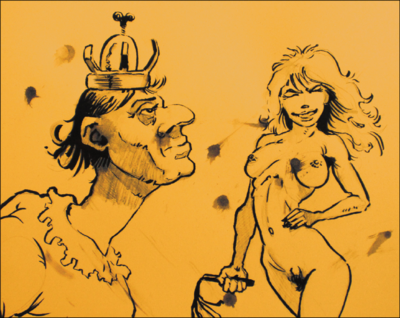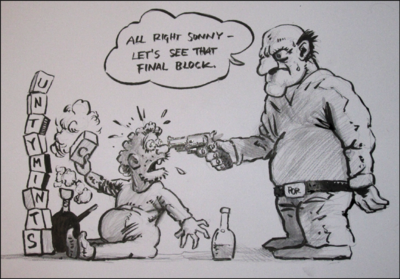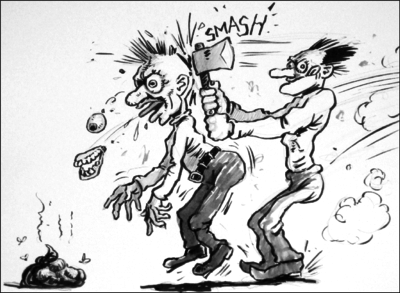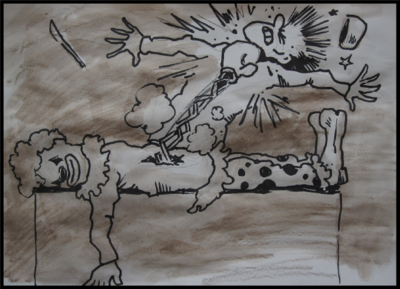Uncyclopedia:Competing Style Guide

Style Guide - that magnum opus of comedic writing - has always been the central piece of wisdom on Uncyclopedia. Whoever contests it had better start thinking about a career elsewhere. It's not so much the fact that a style is necessary for comedic writing as that following orders is totally necessary everywhere in life. We will give you an example before we start with the guide proper:
Example of the usefulness of a guide in life
Matt - we shall call him Matt for lack of a better name - was an engineer. His career had had its ups and downs, but it had been steadily climbing towards greater success. Then he didn't follow orders and got fired and killed himself. The end.
Pretty convincing, isn't it? Don't let this little story of misplaced ambition and premature death put you off, though: not many editors on Uncyclopedia would kill you. However - let us get on with the business at hand.
Section one: tools[edit source]
This section will deal exclusively with your rights as a contributor to Uncyclopedia. It is designed to give you an impression of infinite wisdom in our possession. We want to appear the ultimate gurus of comedic writing, and as far as you are concerned as a new editor, that is actually what we are. Many of us have a degree. Many of us are adults. Our mental health has not been put into question as far as you know. My brother used to write funny things on the inside his desk at school 25 years ago.
We know everything about satire while you don't. If we take this premise and follow it all through this article, everything we claim will appear true, am I right? If we started this article by questioning ourselves, we would not be worth much as plumbers of the human psyche, am I not right? Let us go ahead, then.
Satire is not something you can eat. So far, so good, correct? Correct. Satire is a living piece of a mental process of someone who really can (can they, though?) write something unbelievable while acting as if he can not. This is called false modesty. It is a common disease among our editors. It really is deplorable. Why doesn't everyone just shut up while I'm writing this?
Section two: technique[edit source]
We are now pretty deep into the Style Guide already. We have barely skimmed the surface. You probably have noticed by now that we haven't said much about actual style, haven't you? That is just part and parcel of your indoctrination. If we gave it all up in the introduction, you would just write us right off the map, right? So don't expect any useful piece of information. Instead, immerse yourself in our perceived wisdom that comes out as enigmatic sentences. We keep this simple on purpose. We are simple people and we write simple things.
Indoctrination, introduction, information. The big three. Never go without those if you want to keep in style.
Common mistakes[edit source]
- Who am I to lecture you on mistakes? I am a pathetic person - a total failure. It is so sad. I wish I was dead, and so does everyone else. Other than that, I consider myself superhuman.
- Mistakes are the salt of the earth - just like it says in the Style Guide.
- Mentioning donkey balls FETISH show without circularity
- Numismatics
- Whimper like a dog if you want to get attention at a board meeting.
Less-than-common mistakes[edit source]
If you have actually read this far, which I doubt - but you will never find out I doubt it because you obviously haven't read this far - and if you have, you know by now I doubt it --- and so forth. This is to say we should probably start talking about style already, because there is nothing to prevent us - except the fact that we are not actually talking. Do they say "talking" when they actually mean writing? I doubt that, too.
How to remedy your errors[edit source]
It's a hell of a thing writing a Style Guide. One thinks one knows all sorts of things about how others should be writing their articles, and when the time comes to prove it, one has nothing useful to tell them. These headers and the table of contents make this article look like an actual one, while the images on the right-hand column make it look like a comedic one. The whole site looks somehow credible. Only the words written in these articles reveal the vastness of our ignorance and the huge lack of any meaningful message. Inwards, the site is like a grotto full of invisible demons ready to mock you for trying.
Section three: how to use what you have learned[edit source]
You don't see I am actually suffering here, do you? Can you not appreciate the fact that I am doing my best to write this guide and it is turning - I am not calling this a bad guide, mind you. I just want to let you know that in the world of competition, a competing Style Guide should somehow succeed better than the other Style Guide. I must confess that I have never even read the other one. I just wanted to write a better one - and while I sometimes doubt my own abilities - look, this is actually all filler, all right? The images are the reason I wrote all this. Those and a couple of jokes somewhere earlier in the article. You will have to give me credit for one thing, though: I did not copy/paste any of this, except for the following section:
Section three: how to use what you have learned[edit source]
You don't see I am actually suffering here, do you? Can you not appreciate the fact that I am doing my best to write this guide and it is turning - I am not calling this a bad guide, min
Section four: don't do this[edit source]
By way of actual advice on style, don't ever do anything like this:
| “ | Maine Question 1 was a voter referendum conducted in Maine in 2009 that rejected a bill legalizing same-sex marriage in the state. The measure passed 53%–47% on November 3, 2009.
The outcome of the referendum would be reversed by Maine voters just two years later as a result of Maine Question 1, 2011, which legalized same-sex marriage in the state again. Then they rejected the law again in 2012, and they passed it once again in 2013. The next rejection will be due in 2014 and the next passing is scheduled for 2015. |
” |
As you can see, there is a lot of historical inaccuracy involved. This is unacceptable.
Thank you for reading this article!



